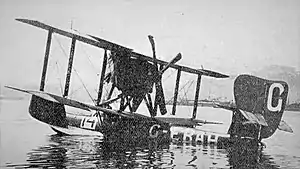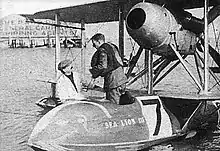| Sea Lion II | |
|---|---|
 | |
| Role | Racing flying-boat |
| National origin | UK |
| Manufacturer | Supermarine Aviation Works |
| Designer | R.J. Mitchell |
| First flight | 1922 |
| Number built | 1 |
| Variants | Sea Lion III |
The Supermarine Sea Lion II was a British racing flying boat built by the Supermarine Aviation Works. Designed by Reginald Mitchell, it was a modification of Supermarine's Sea King II. Sea Lion II was powered by a 450 hp (340 kW) Napier Lion engine.
Entered for the 1922 Schneider Trophy race at Naples, Sea Lion II was planned to be able to attain a speed of 160 miles per hour (260 km/h). It competed against two Italian aircraft. Henry Biard flew the aircraft to victory at an average speed of 145.7 mph (234.5 km/h)—the first post-World War I success by a British aeroplane in an international competition.
For the following year's race, the aircraft's design was modified by Mitchell and re-engined. Renamed Supermarine Sea Lion III, it managed third place, reaching a speed of 151.16 mph (243.27 km/h). After this failure, Supermarine began designing seaplanes instead of flying boats as racers.
Development

The Schneider Trophy race for seaplanes and flying boats had been won by Italy in 1920 (by a Savoia S.19 flying boat, the only aircraft to take part in the meeting) and again in 1921 by a Macchi M.7, in another uncontested race. A third consecutive Italian victory would result in the Trophy being permanently retained by Italy, so Supermarine decided to enter the 1922 competition, with a self-funded entry (Italian and French entries were funded by their respective governments).[1] In order to compete, Supermarine, based at Woolston, Southampton, developed a racing flying boat as a modification of their Sea King II fighter.[2] The Sea King was a single-seat biplane amphibian powered by a 300 hp (220 kW) Hispano Suiza engine in pusher configuration that had first flown in 1921.[2] It was of similar layout to the Supermarine Sea Lion I that had competed in the 1919 Schneider Trophy race, with the Sea Lion I a modified version of the earlier Supermarine Baby, a flying boat fighter aircraft of the First World War.[3]
The aircraft was modified by Supermarine's chief designer and chief engineer, Reginald Mitchell,[4] as a flying boat with a 450 hp (340 kW) Napier Lion engine,[2] loaned by Napier.[5] The new engine resulted in an increase in power of 50 per cent;[6] Mitchell hoped the aircraft would be able to reach a speed of 160 miles per hour (260 km/h), which if attained would make it the fastest in Britain at that time.[7] His modifications to the rudder and the fin caused the hull to have to be strengthened, which was accomplished by an extra layer of varnished fabric being stretched around the structure.[6]
The Sea Lion II was registered as G-EBAH.[2]
Schneider Trophy races
The Sea Lion II was entered into the 1922 Schneider Trophy race,[2] which took place at Naples on 12 August 1922 after the Italians brought the initial date for the race forward by two weeks.[4][7] High winds restricted the time available for the plane to be flight tested in England.[7] The aircraft was dismantled before being put into crates and transported to Naples on board SS Philomel, free of charge.[6][7] The Sea Lion II competed against two Italian aircraft, a Macchi S.7 and a Savioa S.19, with two French entrants failing to start the race.[8][9] The course consisted of 13 laps, each of length 17.7 miles (28.5 km).[4] The race was uneventful;[6] Sea Lion II was flown by Henry Biard, who won the race at an average speed of 145.7 mph (234.5 km/h),[2] and took over one and a half minutes less time to complete the course than the second-placed aircraft, flown by Alessandro Passaleva.[9] The victory was the first post-World War I success by a British aircraft in an international competition, and generated a large amount of publicity for Supermarine.[6]

For the 1923 Schneider Race (held at Cowes on the Isle of Wight) the aircraft was re-engined with a 550 hp (410 kW) Napier Lion and renamed as Sea Lion III.[2] The hull was modified by Mitchell to reduce drag forces,[10] and he gave it two bay wings and a larger rudder area.[2] Mitchell expected the Sea Lion III to attain speeds in excess of 160 miles per hour (260 km/h);[10] the aircraft managed third place behind the American Curtiss CR-3 seaplanes, reaching a speed of 151.16 mph (243.27 km/h).[2] Supermarine's managing director Hubert Scott-Paine said after the trophy was won by the Americans:[11]
Our drawing office people got all the speed they possibly could out of the machine. We did the best we could and have no regrets. Sea Lion III was 11 mph faster than Sea Lion II, and the credit for this fine performance was due to several people, one of whom is Mr. R.J. Mitchell, who designed both machines.
— Hubert Scott-Paine
The British defeat caused Supermarine to abandon using outclassed flying boats as racers, in favour of seaplanes.[11] The Sea Lion III was transferred to the Royal Air Force in 1923.[2]
Operators
Specifications (Sea Lion II)
Data from Supermarine Aircraft since 1914[12]
General characteristics
- Crew: 1
- Length: 24 ft 9 in (7.54 m)
- Wingspan: 32 ft 0 in (9.75 m)
- Wing area: 384 sq ft (35.7 m2)
- Empty weight: 2,115 lb (959 kg)
- Gross weight: 2,850 lb (1,293 kg)
- Powerplant: 1 × Napier Lion II W-12 water-cooled piston engine, 450 hp (340 kW)
- Propellers: 4-bladed fixed-pitch wooden pusher propeller
Performance
- Maximum speed: 160 mph (260 km/h, 140 kn)
- Endurance: 3 hours
See also
Related lists
References
- ↑ Andrews & Morgan 1987, pp. 5, 60.
- 1 2 3 4 5 6 7 8 9 10 Jackson 1988, p. 314.
- ↑ Andrews & Morgan 1987, pp. 52, 57–59.
- 1 2 3 Baker 1994, p. 144.
- ↑ Andrews & Morgan 1987, p. 60.
- 1 2 3 4 5 Pegram 2016, p. 36.
- 1 2 3 4 Mitchell 2006, p. 45.
- ↑ Lewis 1970, p. 125.
- 1 2 Flight 17 August 1922, p. 465.
- 1 2 Mitchell 2006, p. 51.
- 1 2 Mitchell 2006, p. 53.
- ↑ Andrews & Morgan 1987, p. 68.
Sources
- Andrews, C. F.; Morgan, E. B. (1987). Supermarine Aircraft since 1914. London: Putnam. ISBN 978-0-85177-800-6.
- Baker, David (1994). Flight and Flying: a chronology. New York: Facts on File. ISBN 978-08160-1-854-3.
- "The British Victory at Naples: Supermarine Wins the Schneider Cup Race". Flight. Vol. 14, no. 712. 17 August 1922. pp. 465–644.
- Jackson, A. J. (1988). British Civil Aircraft 1919–1972: Volume III. London: Putnam. ISBN 978-0-85177-818-1.
- Lewis, Peter (1970). British Racing and Record-Breaking Aircraft. London: Putnam. ISBN 978-0-370-00067-1.
- Mitchell, Gordon (2006). R.J. Mitchell: Schooldays to Spitfire. Stroud: Tempus. ISBN 978-07524-3-727-9.
- Pegram, Ralph (2016). Beyond the Spitfire: The Unseen Designs of R.J. Mitchell. Pegram: The History Press. ISBN 978-0-7509-6515-6.
Further reading
- Eves, Edward; Coombs, L. F. E. (2001). The Schneider Trophy Story. St. Paul, Minnesota: MBI Pub. ISBN 978-07603-1-118-9.
- "The Schneider Cup International Seaplane Race: America Scores a Well-Deserved Win". Flight. Vol. 15, no. 771. 4 October 1923. pp. 592–599.
- Shelton, John (2008). Schneider Trophy to Spitfire - The Design Career of R.J. Mitchell. Sparkford: Hayes Publishing. ISBN 978-1-84425-530-6.
External links
![]() Media related to Supermarine Sea Lion II at Wikimedia Commons
Media related to Supermarine Sea Lion II at Wikimedia Commons
- Supermarine Sea Lion – British Aircraft Directory